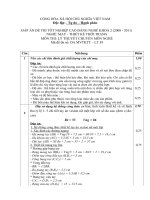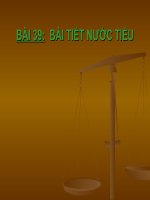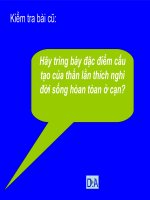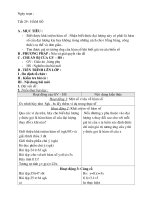PASSAGE 39
Bạn đang xem bản rút gọn của tài liệu. Xem và tải ngay bản đầy đủ của tài liệu tại đây (46.32 KB, 4 trang )
PASSAGE 39
The hit movie Finding Nemo follows a clownfish that is scooped up from the Great Barrier Reef. In
real life, clownfish are among the thousands of colorful sea creatures that call the Great Barrier Reef
home.
Stretching 1,250 miles along Australia’s northeastern coast, the Great Barrier Reef is the longest coral
reef in the world. A coral reef is a living underwater structure. But these days, the Great Barrier Reef has
found itself in trouble. Overfishing, pollution, and high temperatures are harming its health. That’s why
the government in Australia is trying to help rescue the reef.
While coral may look like a plant, it is actually made up of tiny sea animals. Those sea animals are
called coral polyps. As polyps die, they leave hard shells behind. Other polyps grow on top of the shells.
Over thousands of years, they form a coral reef in warm water that is not very deep.
In many ways, the Great Barrier Reef resembles an underwater garden. Coral can be hard or soft. It
forms in different colors and in strange shapes. Some coral looks like hardened brains. Other coral looks
like fans and lettuces. The reef bursts with schools of tropical fish, darting among gaps in the coral.
The reef supplies food and shelter to creatures living in and around the coral. Turtles, sharks, sea
horses, and crabs are among its many inhabitants.
While the reef is important to ocean life, it helps humans, too. People rely on the reef for both food and
jobs. It also provides medicine used to treat disease. Each year, Great Barrier Reef contributes about
$975 million to the economy through tourism and fishing.
Is it surprising, then, that the Great Barrier Reef is under too much stress? Fishing nets and ships break
off sections and damage the reef. Air and water pollution are also doing harm. At the same time, warmer
sea temperatures have caused coral bleaching on half of the reef. The high temperatures cause the coral to
turn white often killing it.
In an effort to help save the reef, the government has limited fishing to two-thirds of it. That plan
increases the number of “green zones”. Those are areas that are off-limits to fishermen and boats.
However, tourists and researchers can still visit them. The Australia government says that its plan will
help keep the reef safe from some threats.
(Weekly Reader 2009)
Question 1. Where is the Great Barrier Reef?
A. in northwestern coast of Australia
B. in southeastern coast of Australia
C. in the northeastern coast of Australia
D. in southwestern coast of Australia
Question 2. Which of the following does not do harm to the Great Barrier Reef?
A. tourists
B. overfishing
C. pollution
D. high temperature
Question 3. Where can the coral reef usually be found?
A. in warm deep water B. in cold shallow water C. in warm shallow water D. in cold deep water
Question 4. Which of the following is NOT a creature that lives in the Great Barrier Reef?
A. coral polyps
B. turtles
C. sea horses
D. whales
Question 5. In paragraph 4, what image does the author most likely want the reader to visualize?
A. Many fish quickly moving through the coral.
B. Fish moving toward the center, or target, of the coral.
C. Fish exploding when they come into contact with gaps in the coral.
Page 1
D. Structured, orderly groups of young fish without a clear path.
Question 6. What does the word “contributes” in paragraph 6 mean?
A. pays the economy
B. makes money for the economy
C. owes the economy
D. costs the economy
Question 7. What is this passage mostly about?
A. The causes of reef problems and possible solutions
B. Coral bleaching, which causes the reef to turn white
C. Overfishing and higher temperatures
D. the history of tourism to the Great Barrier Reef
Question 8. According to the passage which of the following sentences is true?
A. The clownfish is the only colorful creatures found in the Great Barrier Reef.
B. The Great Barrier Reef is the second longest coral reef in the world.
C. Coral is a kind of plant because it is made up of dead coral polyps.
D. Coral forms in strand shapes and in different colors.
ĐÁP ÁN
1-C
2-A
3-C
6-B
7-A
8-D
4-D
5-A
LỜI GIẢI CHI TIẾT
Question 1:
Rạn san hơ Great Barrier ở đâu?
A. ở bờ biển phía tây bắc của Úc
B. ở bờ biển phía đơng nam Australia
C. ở bờ biển phía đơng bắc Australia
D. ở bờ biển phía tây nam Australia
=> Dẫn chứng: Stretching 1,250 miles along Australia’s northeastern coast, the Great Barrier Reef is the
longest coral reef in the world.
Dịch: Trải dài 1.250 dặm dọc theo bờ biển đông bắc của Australia, Great Barrier Reef là rạn san hô dài
nhất trên thế giới.
Question 2:
Điều nào sau đây không gây hại cho Rạn san hô Great Barrier?
A. khách du lịch
C. ô nhiễm
B. đánh bắt quá mức
D. nhiệt độ cao
=> Dẫn chứng: But these days, the Great Barrier Reef has found itself in trouble. Overfishing, pollution,
and high temperatures are harming its health. That’s why the government in Australia is trying to help
rescue the reef
Dịch: Nhưng những ngày này, Great Barrier Reef đã gặp rắc rối. Đánh bắt quá mức, ô nhiễm và nhiệt độ
cao đang gây hại cho sức khỏe của nó.
Question 3:
Page 2
Các rạn san hơ thường có thể được tìm thấy ở đâu?
A. ở vùng nước sâu ấm
B. ở vùng nước nông lạnh
C. ở vùng nước nông ấm
D. ở vùng nước sâu lạnh
=> Dẫn chứng: Over thousands of years, they form a coral reef in warm water that is not very deep.
Trải qua hàng ngàn năm, chúng tạo thành một rạn san hô trong nước ấm không sâu lắm.
Question 4:
Điều nào sau đây KHÔNG phải là một sinh vật sống trong rạn san hô Great Barrier?
A. polyp san hô
B. rùa
C. cá ngựa
D. cá voi
=> Dẫn chứng: While coral may look like a plant, it is actually made up of tiny sea animals. Those sea
animals are called coral polyps.[…] The reef supplies food and shelter to creatures living in and around
the coral. Turtles, sharks, sea horses, and crabs are among its many inhabitants.
Dịch: Trong khi san hơ có thể trơng giống như một cái cây, nó thực sự được tạo thành từ những động vật
biển nhỏ bé. Những động vật biển được gọi là polyp san hô. […] Các rạn san hô cung cấp thức ăn và nơi
trú ẩn cho các sinh vật sống trong và xung quanh san hô. Rùa, cá mập, cá ngựa và cua là một trong số
nhiều cư dân của nó.
Question 5:
Trong đoạn 4, tác giả rất có thể muốn người đọc hình dung ra hình ảnh nào?
A. Nhiều lồi cá nhanh chóng di chuyển qua san hơ.
B. Cá di chuyển về phía trung tâm, hoặc mục tiêu, của san hô.
C. Cá phát nổ khi chúng tiếp xúc với những khoảng trống trên san hơ.
D. Các nhóm cá non có cấu trúc, có trật tự
=> Dẫn chứng: Other coral looks like fans and lettuces. The reef bursts with schools of tropical fish,
darting among gaps in the coral.
Dịch: San hô khác trông giống như quạt và rau diếp. Các rạn san hô bùng nổ với những đàn cá nhiệt đới,
phóng ra giữa những khoảng trống trong san hơ.
Question 6:
Từ "contributes" trong đoạn 6 có nghĩa là gì?
A. trả tiền cho nền kinh tế
B. kiếm tiền cho nền kinh tế
C. nợ nền kinh tế
D. chi phí nền kinh tế
=> contributes : đóng góp
Question 7:
Đoạn văn này chủ yếu là về cái gì?
A. Nguyên nhân của các vấn đề rạn san hơ và các giải pháp có thể.
B. Tẩy trắng san hô, làm cho rạn san hô chuyển sang màu trắng
C. Đánh bắt quá mức và nhiệt độ cao hơn
D. lịch sử du lịch đến rạn san hô Great Barrier
=> Dẫn chứng: Fishing nets and ships break off sections and damage the reef. Air and water pollution are
also doing harm. At the same time, warmer sea temperatures have caused coral bleaching on half of the
reef. The high temperatures cause the coral to turn white often killing it.
Page 3
In an effort to help save the reef, the government has limited fishing to two-thirds of it. [...] The Australia
government says that its plan will help keep the reef safe from some threats
Dịch: Lưới đánh cá và tàu phá vỡ các phần và làm hỏng rạn san hơ. Ơ nhiễm khơng khí và nước cũng
đang làm hại. Đồng thời, nhiệt độ nước biển ấm hơn đã khiến san hô tẩy trắng trên một nửa rạn san hô.
Nhiệt độ cao khiến san hơ chuyển sang màu trắng thường giết chết nó.
Trong nỗ lực giúp cứu rạn san hơ, chính phủ đã giới hạn việc đánh bắt ở hai phần ba trong số đó. [...]
Chính phủ Úc nói rằng kế hoạch của họ sẽ giúp giữ rạn san hơ an tồn trước một số mối đe dọa
Question 8:
Theo đoạn văn nào sau đây là đúng?
A. Cá hề là sinh vật đầy màu sắc duy nhất được tìm thấy trong Rạn san hơ Great Barrier.
B. Rạn san hô Great Barrier là rạn san hô dài thứ hai trên thế giới.
C. San hô là một loại thực vật vì nó được tạo thành từ các polyp san hơ đã chết.
D. San hơ hình thành trong các hình dạng sợi và màu sắc khác nhau.
=> Dẫn chứng: In many ways, the Great Barrier Reef resembles an underwater garden. Coral can be hard
or soft. It forms in different colors and in strange shapes.
Theo nhiều cách, Great Barrier Reef giống như một khu vườn dưới nước. San hơ có thể cứng hoặc mềm.
Nó hình thành trong các màu sắc khác nhau và trong hình dạng kỳ lạ.
Page 4









